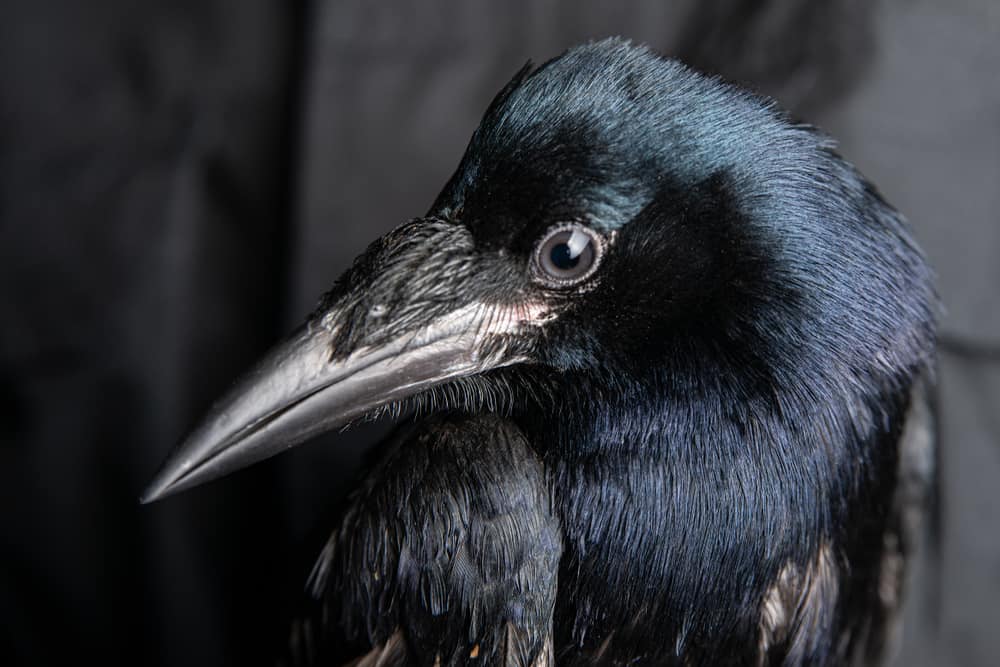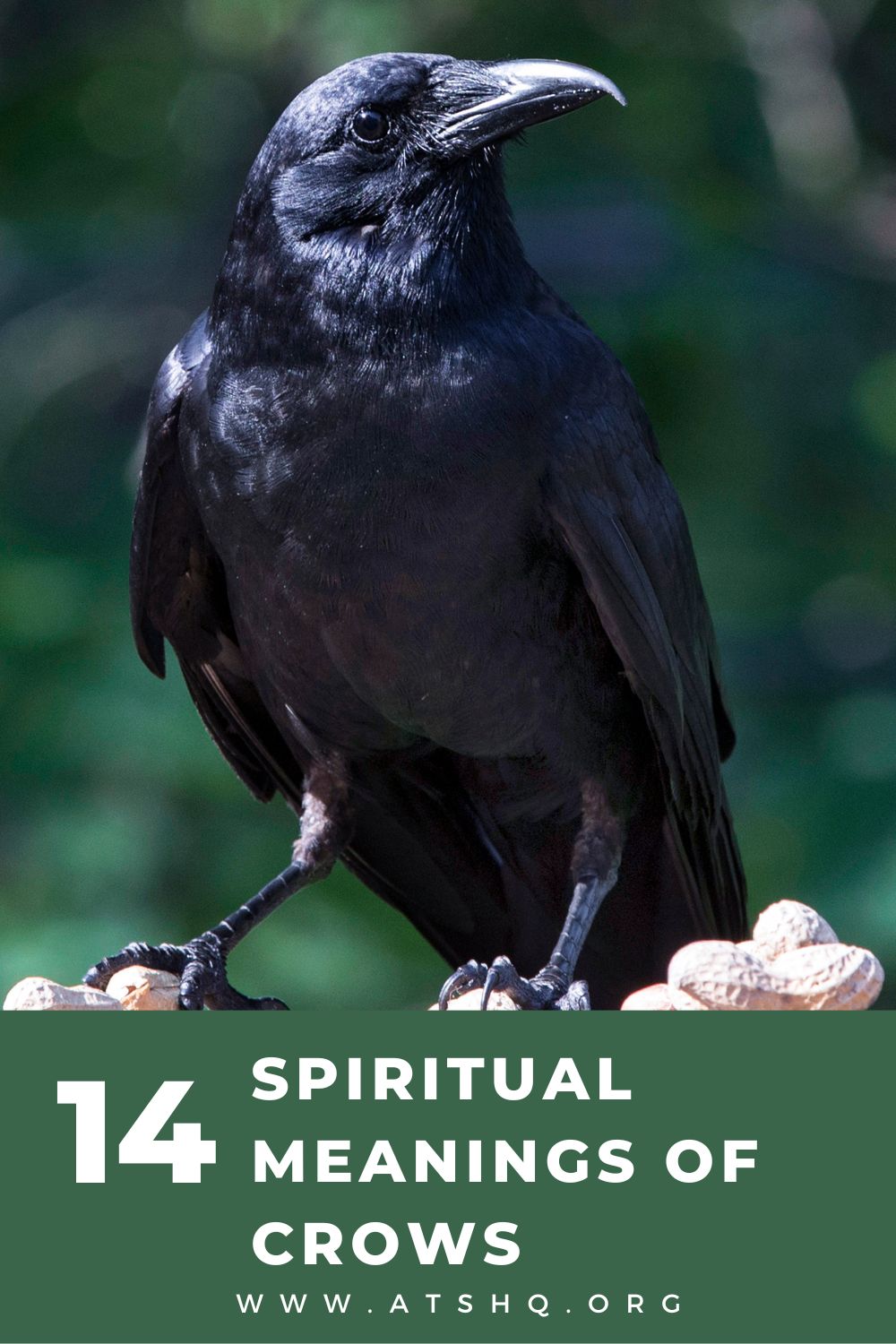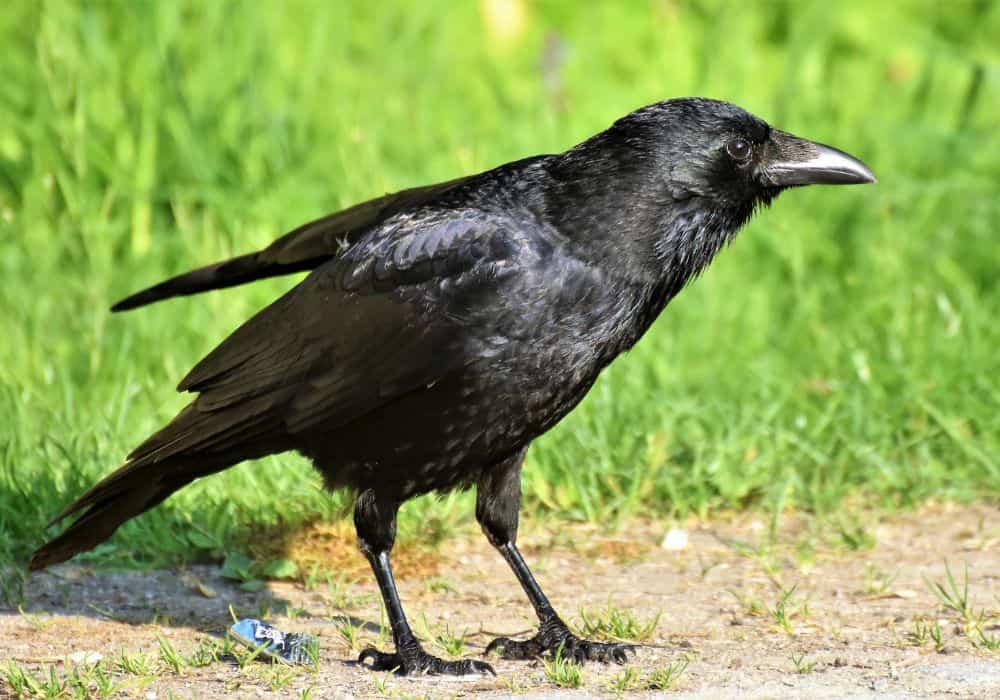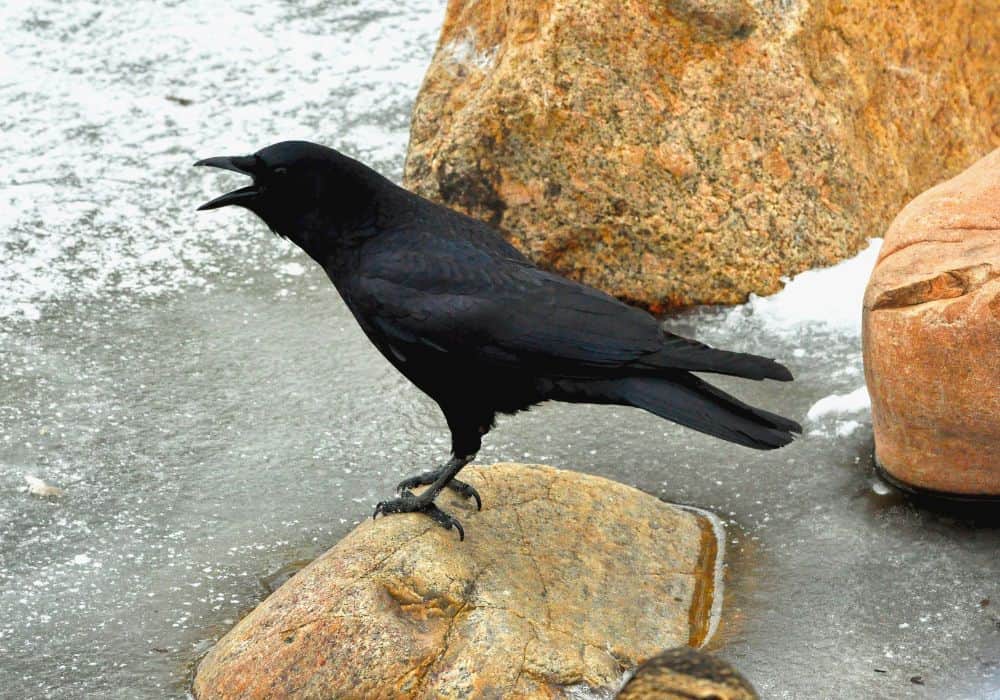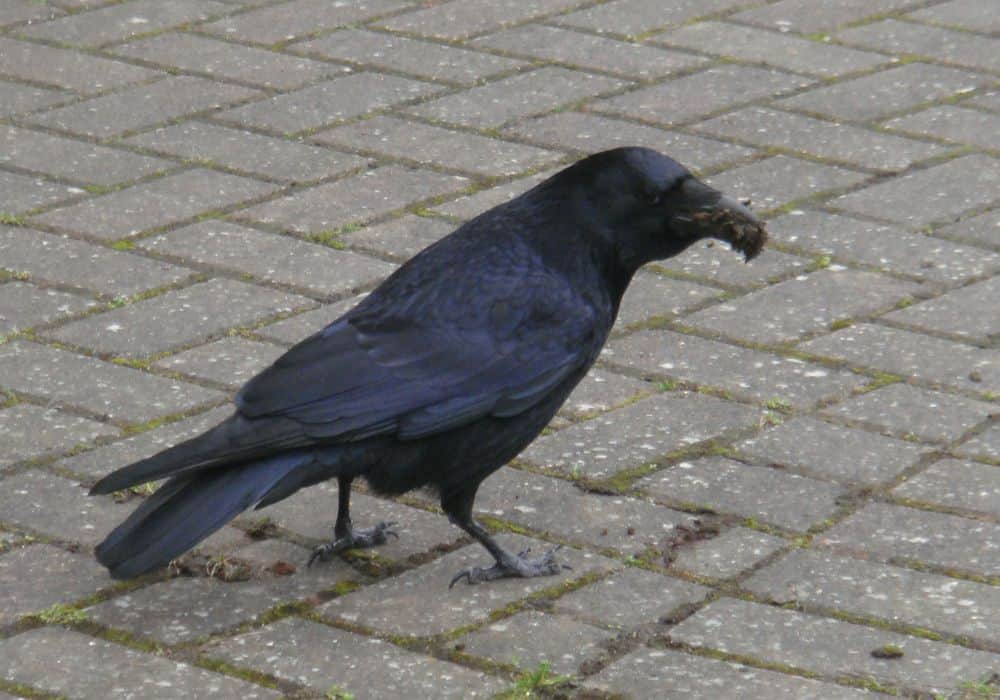Crows can be found in almost every city, town and village, wood, forest, and field, on every mountainside and in every valley, in almost every country in the world. The fossil record of crows is ancient and complex, suggesting that for at the very least as long as human beings have been wandering this earth, they have been in contact with crows.
Unsurprisingly, therefore, there is a wealth of symbolism, mythology, folklore and omens surrounding these curiously-intelligent, robust and sleek-black beasts of the sky. To this day, no matter where or who you are, you probably have some inexplicable gut feeling (good, bad, or a mix of both) whenever you see a murder of crows cawing in the trees.
In this article, we’ll take you on a journey through time and space to the world of the mighty Corvid. We’ll first learn a little about crows – their appearance, behavior, history, etc. – before diving head first into the various crow meanings, symbols and stories attached to them by just about every civilization which has ever existed.
As totem animals, spirit animals, and power animals, we’ll strive to separate legend from legitimate in our quest to understand why humankind has been fascinated with crows since the dawn of time. Let’s get started!
An Introduction to Crows
Crows are medium- to large-sized passerine birds found in the genus Corvus, which also includes ravens and jackdaws.
The term ‘crow’ may also commonly be found in use as an umbrella term for the entire Corvus genus (though, of course, this would not be scientifically accurate).
There are about 34 different species of crow around the world, each sharing many similar features, habitats, and behaviors.
Crows are extremely common birds in most parts of the world, and can be found near trash cans and dump sites wherever there are humans to fill them.
As omnivores, crows will eat just about anything, including other birds, nuts, molluscs, fruit, frogs, eggs of any kind, worms, seeds, baby birds (chicks), mice, rats and carrion (dead animals killed by other predators).
Part of the ominous, foreboding sense of dread and death which surrounds much of crow meaning and folklore has surely to do with their dietary habits.
Here’s a list of the 34 different species of crow, with those found in the Americas highlighted in bold and underlined:
- Pied crow (Central African coasts to southern Africa)
- Little crow (Australia)
- American crow (United States, southern Canada, northern Mexico)
- Cape crow or Cape rook (Eastern and southern Africa)
- Hooded crow (Northern and Eastern Europe and Northern Africa)
- Carrion crow (Europe and eastern Asia)
- Indian jungle crow (South Asia)
- Somali crow or dwarf raven (eastern Africa)
- Slender-billed crow (Malaysia, Borneo, Indonesia)
- Flores crow (Flores Island)
- Brown-headed crow (New Guinea)
- Hawaiian crow (Hawaii)
- Tamaulipas crow (Gulf of Mexico coast)
- Bismarck crow (Bismarck Archipelago, Papua New Guinea)
- Jamaican crow (Jamaica)
- Mariana crow or aga (Guam, Rota)
- White-necked crow (Haiti, Dominican Republic, Puerto Rico)
- Eastern jungle crow (India, Burma)
- Large-billed crow
- Bougainville crow or Solomon Islands crow (Papua New Guinea, Northern Solomon Islands)
- New Caledonian crow (New Caledonia, Loyalty Islands)
- Cuban crow (Cuba, Isla de la Juventud, Grand Caicos Island)
- Torresian crow or Australian crow (Australia, New Guinea and nearby islands)
- Fish crow (South-eastern U.S. coast)
- Palm crow (Cuba, Haiti, Dominican Republic)
- Sinaloa crow (Pacific coast from Sonora to Colima)
- House crow or Indian house crow (South Asia, Middle East, east Africa)
- Collared crow (Eastern China, south into Vietnam)
- Grey crow or Bare-faced crow (New Guinea and neighboring islands)
- Piping crow or Celebes pied crow (Sulawesi, Muna, Butung)
- Banggai crow (Banggai Island)
- Long-billed crow (Northern Moluccas)
- Violet crow (Seram)
- White-billed crow or Solomon Islands crow (Solomon Islands)
Crow Appearance
There are many small variations in appearance between the various species of crow, but by and large they share several distinct features which mark them clearly as crow Corvids.
Crows are strong and sleek in appearance, a crow’s feathers being glossy and usually deep black, blue-black, or a mixture of dark-gray and black feathers. They have small heads ending in thick, sharp-looking beaks which taper at the end into a slightly-downwards curve. Their legs are also evidently strong, stockinged to the knee, below which they are scaly and gray. They have a broad wingspan and a wedge-shaped tail.
Crows are often confused with ravens, despite ravens being a different species group altogether. The best way to tell the two apart is that ravens tend to be larger and with a thicker beak than crows.
Crow Habitat
Crows survive and are prolific in most parts of the world. They can adapt to just about any environment, as well, from tundra to desert, sea-cliffs to open plains, urban cities to rural farms, and everything in between.
Some crow species have evolved in accordance with their environment, and yet almost all species can – even still – adapt even further to any change within that environment, or to the environment as a whole.
In short, crows are expert survivalists, which is perhaps why they have been so pervasive to human thought, mythology, superstition and storytelling throughout history.
Crow Behavior
As with other cultural spirit animals, the behavior of crows has a great deal to do with the mythologies surrounding them.
Just like we humans, crows have a specific tendency toward communities: specifically, large communities. As communal birds, you’ll find that crows will roost in groups comprising anywhere between 200 and several thousand others.
They also speak to each other in such a wide variety of ways that it is clear just how intelligent they are. They even speak to other birds, and to entirely different animal groups – most often predators like wolves, alerting them to prey.
Crows have a mutualistic relationship with predators like wolves; both animals benefit from the interaction. In fact, wolf kills during winter have been found to involve crows and other Corvids almost 100% of the time.
People throughout time will have seen crows acting so cleverly, and have been mystified by their actions, leading to much of the superstition surrounding these creatures.
Crow Intelligence
Crows have long been associated with wisdom, thought, foresight and more, but only recently have scientists been able to determine just exactly how intelligent crows are. Which is to say: very!
In fact, crows are today regarded as some of the most intelligent animals in the entire world, with an IQ roughly equivalent to a 7-year-old human, or our primate ancestors.
Not only can crows use tools they find in the world around them, like bread for bait fishing, or rocks for smashing, they can even make their own tools when needed. Crows in Japan have learned how to operate local drinking fountains, even adjusting the water pressure between pressures suitable for drinking and for bathing.
Perhaps most impressively, not only can crows and ravens recognize themselves in mirrors (one of the foundational measurements of self-awareness and intelligence), but they are also capable of displacement: the ability to communicate with each other about things which are not immediately present, either spatially or temporally.
The intelligence of crows has, without a doubt, contributed much to the mysterious and often fearful language surrounding them.
Crow Meaning
Meanings and symbols associated with the sighting or presence of crows vary greatly from culture to culture. As such, it’s clear that we can’t just simply claim that crows mean one thing or the other, as some misleading, lazily slapped-together videos and articles tend to do.
Nevertheless, we can compile a list of the various meanings which have become associated with crows over time. Here it is:
- Good luck
- Bad luck
- Intuition
- Intelligence
- Adaptability
- Survival instinct
- Cleverness
- Prosperity
- Death
- War
- Violence
- Symbol of transformation
- Teamwork
- Insight
The History of Crow Symbolism and Mythology
Crows have featured, quite interestingly, in the origin stories and mythologies of the vast majority of world religions and civilizations.
They appear in the Bible, al-Qurʾān, in Buddhism, Hinduism, and in Old Norse mythology. They feature in the folklore of indigenous tribes and in that of ancient towering civilizations.
Somehow, crow folklore often even shares similar tropes, such as the three-legged crow, or the crow that drives the sun, or of how fire was introduced to humanity by a crow (a feature of both Aboriginal Australian and Lenape Native American mythology).
The Symbolism of Crows in Global Culture: Past and Present
Aboriginal Australian Symbolism
It is thought that crows evolved from an early Corvid native to Australia. Perhaps it should come as no surprise, therefore, that the Aboriginal peoples of Australia have much to say about crows and their meaning.
To Aborigines, Crow is a trickster deity well-known for his intelligence, wisdom, cunning and trickery. For Aboriginal Australians, Crow is known for his jealousy and selfishness as well. He stole fire, left the physical world behind to become the second brightest star in the sky, and is even responsible for harassing the dead on their way to the afterlife, or spiritual world.
Crows in Western Aboriginal Australian mythology are important totem animals. Those with a crow totem animal will often talk of how it is the fault of the vain magpie that crows are now completely black, since the magpie fought with the crow and together they fell into a sooty fire.
Ancient Mesopotamian Symbolism
In the Epic of Gilgamesh, a character called Utnapishtim is out to sea in an ark, following a great flood which covered all the world in water.
He first sends up a dove to search for land, but when the dove does not return, he sends instead a crow flying which, being a better survivor and more intelligent than the dove, flies until he finds land, never returning to Utnapishtim.
This story was copied and repeated several thousand years later in the Christian Bible, with names changed to make it appear original. In both stories, the journey of the crow symbolises both resilience and mutual-dependency between humans and animals.
Chinese Symbolism
The Ancient Chinese believed that there were originally ten suns in the sky, each pulled through space by a deific crow. One day, however, all ten crows surfaced above the earth at the same time, their suns in tow.
The heat being unbearable, all of the crops were scorched black and rendered useless, and the people began to starve. In order to rectify this, the gods sent the best archer they had – a man called Hou Yi – to solve the problem.
Hou Yi shot down nine out of ten of the sun crows, leaving only the one sun we have today.
Writer’s note: I find it exceptionally interesting just how often crows are either equated with the sun, stars, the overseers of the sun, and/or with the introduction of fire to humankind. Why should this be the case?
Hindi Symbolism
Crows feature far too much in Hindi mythology for me to relate each and every occurrence here. Suffice it to say that they are believed to be messengers: carriers of information which bring specific omens to people in different ways, with the omen being different depending on the context of the crow’s visit.
In Hinduism, crows may symbolise both good luck and bad luck simultaneously, which is perhaps due to the fact that they are believed to carry the souls of the recently deceased.
During certain times of year and certain festivals, such as during Śrāddha and Pitru Paksha, it is customary to feed crows, in the belief that in doing you one is feeding one’s own ancestors.
Celtic Symbolism
Crows are also integral to much of Celtic mythology, from ancient Wales and Ireland to medieval England, Cornwall and Scotland.
The Irish goddess The Morrigan (Mór-Ríoghain), overseer of war, fate and prophecy, is closely associated with crows, leaning once again into the notion that crows – due to their genuinely impressive memories, and the ancient (incorrect) belief that they lived for many hundreds of years – can see into the future. The Morrigan often appears to others as a crow.
Similarly, in Welsh mythology, it is said that witches could transform themselves into crows; symbolising deception and magic. The Welsh god Brân the Blessed‘s name literally means “The Blessed Crow”.
Since crows are carrion feeders, they would almost always be found on a battlefield once the fight was over, picking at the meat of fallen warriors. As such, they carried the spiritual meaning of death. A phrase arose in Celtic society: “the crow pierced you” or “the crow pierced them”, meaning “you have died” or “they died”.
Islamic Symbolism
Crows are not always depicted as frightful tricksters or as the harbinger of death, but sometimes also as friendly, wise and helpful animals. Such is the case with the story of the crow who, seeing that the son of Adam had not yet buried his brother (and thus paid the dead their proper respects), flew down next to the son and dug a grave for a fallen crow, thus teaching the son of Adam – by example – what to do.
Old Norse (Viking) Symbolism
If you know even a little about Viking mythology (or Norse mythology, as it’s better known), then you will know that Odin, god of gods and leader of Valhalla, keeps two ravens on his shoulder. Whilst not crows, per say, these birds are still Corvids and are sometimes referred to as crows.
Huginn and Muninn (translating to “thought” and “memory” or “mind”, respectively), fly all over the world, collecting information (like spies) for Odin, before returning to him to whisper their secrets in his ear. Once again, we see crows playing the symbolic role of intelligence, memory, and duplicity in the suspect and suspicious.
Similarly, it is said that the Valkyries – those winged, terrifying beauties who spirited the fallen away from the battlefield and up to Valhalla – each had a crow spirit animal.
This could quite plausibly be explained by those grieving the loss of their kind, seeing crows pecking at warriors on the battlefield and choosing to believe that these crows were in fact gifts in disguise: angels, taking their loved ones to Viking heaven.
Christian Symbolism
As aforementioned, in Christianity, the story of Noah and his ark was lifted directly from precursor polytheistic religions, such as Chaldean religion of the ancient Mesopotamians. In the biblical retelling of the Great Flood story, however, the raven released by Noah is sometimes viewed as an untrustworthy or unfaithful animal for not returning, rather than as a saviour (as in the Chaldean story).
Native American Symbolism
Crows are hugely prominent in the Native American folklore of a great many different tribes and groups. There is of course the Crow clan, and the Chippewa people whose totem and clan bird is a crow. There are the Tlingit, to whom the crow is their primary deity, and the Haida, who tell of how a crow stole the sun from the gods and gave it to humans on earth for warmth, light and energy.
Conclusion
In most pre-agricultural, nomadic and hunter-gatherer indigenous societies, crows were associated with positive qualities, symbols, omens and portends. Interestingly, with the advent of agriculture (farming) came a change: suddenly, crows – who would peck at and steal crop at harvest time, and seeds during the sewing – began to acquire negative stories and connotations instead. Today, people remain fascinated, getting crow tattoos, claiming crow spirit animals, and generally believing in crow meanings and superstitions with little-to-no grounding in fact.
